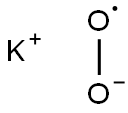Kaliumsuperoxid
|
|
Kaliumsuperoxid Eigenschaften
- Schmelzpunkt:
- 400 °C
- Dichte
- 2,14 g/cm3
- storage temp.
- Store at +15°C to +25°C.
- L?slichkeit
- Soluble in ethanol and ether.
- Aggregatzustand
- powder
- Farbe
- Yellow-green
- Wichte
- 2.14
- PH
- >7 (H2O, 20℃)
- Wasserl?slichkeit
- reacts
- Sensitive
- Air & Moisture Sensitive
- Stabilit?t:
- Stable, but reacts violently with water. Incompatible with moisture, alcohols, strong reducing agents, strong acids, finely powdered metals.
- CAS Datenbank
- 12030-88-5(CAS DataBase Reference)
- NIST chemische Informationen
- Potassium superoxide(12030-88-5)
- EPA chemische Informationen
- Potassium superoxide (K(O2)) (12030-88-5)
Sicherheit
- Risiko- und Sicherheitserkl?rung
- Gefahreninformationscode (GHS)
| Kennzeichnung gef?hrlicher | O,C | ||
|---|---|---|---|
| R-S?tze: | 8-14-34-35 | ||
| S-S?tze: | 17-27-36/37/39-8-45-26 | ||
| RIDADR | UN 2466 5.1/PG 1 | ||
| WGK Germany | 3 | ||
| RTECS-Nr. | TT6053000 | ||
| TSCA | Yes | ||
| HazardClass | 5.1 | ||
| PackingGroup | I | ||
| HS Code | 28259080 |
| Bildanzeige (GHS) |
 
|
|||||||||||||||||||||
|---|---|---|---|---|---|---|---|---|---|---|---|---|---|---|---|---|---|---|---|---|---|---|
| Alarmwort | Achtung | |||||||||||||||||||||
| Gefahrenhinweise |
|
|||||||||||||||||||||
| Sicherheit |
|
Kaliumsuperoxid Chemische Eigenschaften,Einsatz,Produktion Methoden
R-S?tze Betriebsanweisung:
R8:Feuergefahr bei Berührung mit brennbaren Stoffen.R14:Reagiert heftig mit Wasser.
R34:Verursacht Ver?tzungen.
R35:Verursacht schwere Ver?tzungen.
S-S?tze Betriebsanweisung:
S17:Von brennbaren Stoffen fernhalten.S27:Beschmutzte, getr?nkte Kleidung sofort ausziehen.
S36/37/39:Bei der Arbeit geeignete Schutzkleidung,Schutzhandschuhe und Schutzbrille/Gesichtsschutz tragen.
S8:Beh?lter trocken halten.
S45:Bei Unfall oder Unwohlsein sofort Arzt zuziehen (wenn m?glich, dieses Etikett vorzeigen).
S26:Bei Berührung mit den Augen sofort gründlich mit Wasser abspülen und Arzt konsultieren.
Chemische Eigenschaften
light yellow powder or chunksVerwenden
Reagent and intermediate.One use of potassium superoxide,KO2, is for generating oxygen. It has the ability to absorb carbon dioxide, while giving out oxygen at the same time:
4KO2(s)+ 2CO2(g)--->2K2CO3(s)+ 3O2(g)
This property has been made use of in breathing equipment,e.g.for mountaineers, in submarines and in spacecraft.
Allgemeine Beschreibung
A yellowish to white solid. Melting point 948°F. Mixtures with combustible material readily ignite by friction, heat, or contact with moisture. Prolonged exposure to fire or heat may cause vigorous decomposition of the material and rupturing of the container.Air & Water Reaktionen
Reacts explosively with water [Mellor 2, Supp. 3: 1631. 1963].Reaktivit?t anzeigen
Potassium superoxide is a powerful oxidizer. Forms on the surface of potassium metal, solid or molten, that is exposed to the air. Attempts to extinguish burning potassium with powdered graphite has resulted in violent explosions [Chem. Abstr. 63:424. 1965]. Highly oxidized potassium metal was dropped into a dish of ethyl alcohol, an immediate explosion shattered the dish. Potassium superoxide was considered the cause of the reaction [Health and Safety Inf. 251. 1967]. Potassium superoxide should not be added to pure organic materials (hydrocarbons), as ignition and violent explosion may occur. Oxidation of arsenic, antimony, copper, potassium, tin, or zinc proceeds with incandescence, [Mellor, 1941, Vol. 2, 493]. Interaction between the superoxide and diselenium dichloride is violent, [Mellor, 1947, Vol. 10, 897].Hazard
Corrosive to tissue.Health Hazard
TOXIC; inhalation, ingestion or contact (skin, eyes) with vapors, dusts or substance may cause severe injury, burns or death. Fire may produce irritating and/or toxic gases. Toxic fumes or dust may accumulate in confined areas (basement, tanks, hopper/tank cars, etc.). Runoff from fire control or dilution water may cause pollution.Brandgefahr
May explode from friction, heat or contamination. These substances will accelerate burning when involved in a fire. May ignite combustibles (wood, paper, oil, clothing, etc.). Some will react explosively with hydrocarbons (fuels). Containers may explode when heated. Runoff may create fire or explosion hazard.Sicherheitsprofil
Explosive reaction when heated with carbon, 2-aminophenol + tetrahydrofuran (at 65°C). Forms a friction- sensitive explosive mixture with hydrocarbons. Violent reaction with lselenium dichloride, ethanol, potassium- sodium alloy. May ignite on contact with organic compounds. Incandescent reaction with metals (e.g., arsenic, antimony, copper, potassium, tin, and zinc). When heated to decomposition it emits toxic fumes of K2O. See also PEROXIDES.Kaliumsuperoxid Upstream-Materialien And Downstream Produkte
Upstream-Materialien
Downstream Produkte
12030-88-5(Kaliumsuperoxid)Verwandte Suche:
Potassium sorbate
Losartan potassium
Kaliumiodid
Kaliumchlorid
Trikaliumcitrat
Kaliumacetat
Dikaliumperoxodisulfat
Kaliumbromat
Kaliumnitrat
Kalium
Kaliumhydroxid
Dikaliumoxid
Potassium hydroxide solution
Kaliumsuperoxid
Superoxide
Aluminiumkaliumoxid
Diantimontetrakaliumheptaoxid
Niobkaliumoxid
- PotassiuM Superoxide, Uncatalyzed Granules
- PotassiuM Superoxide, Uncatalyzed Granules, 3/8 to 1/4 in.
- Potassium dioxide chunks, 5-10 mm
- burntpotash
- cacinedpotash
- K(O2)
- Potassium oxide super
- Potassium superoxide ko2
- potassiumsuperoxide(k(o2))
- potassiumsuperoxide,ko2,industrial
- potassiumsuperoxide,ko2,industrial-(fluff)
- potassiumsuperoxide,ko2,industrial-(granules)
- dipotassium peroxide
- POTASSIUM PEROXIDE 85
- potassium hyperoxide
- POTASSIUM SUPEROXIDE, POWDER
- POTASSIUM SUPEROXIDE, CHUNKS, 5-10MM
- Potassium superoxide, catalyzed granules, 3.5-5 mesh
- Potassiumsuperoxide,96.5%
- Kaliumperoxid
- potassium superoxide,industrial
- Potassium oxide, super, 96.5%
- POTASSIUM SUPEROXIDE
- Potassium superoxide, chunks
- Potassium dioxide,Potassium superoxide
- POTASSIUM SUPEROXIDE FOR SYNTHESIS
- Potassium superoxide, min. 96%
- KLHFBSUAIFRMED-UHFFFAOYSA-N
- PotassiuM dioxide powder
- POTASSIUM DIOXIDE
- 12030-88-5
- K2O2
- metal oxide







